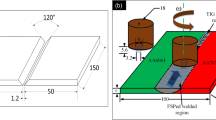Abstract
With the industrial use of FSW growing steadily, non-destructive testing methods that can detect the impending formation of flaws during welding must be developed. The present work accomplished two goals. First, the distribution of oxide fragments within aluminium welds could be correlated with certain welding process variables. Consequently, an approach was suggested to prevent the conglomeration of oxide fragments in the weld by reducing the surface roughness of the abutted edges. Second, welding forces can be used to predict the formation of elongated cavities inside the weld. This project showed that by monitoring the welding forces, the ability to change the welding variables in real time could prevent the formation of flaws in friction stir welds.
Similar content being viewed by others
References
Kallee S.W.: Friction Stir Welding in Series Production, TWI, UK 2004.
Imuta M., Kamimuki K.: Development and application of Friction Stir Welding for aerospace industry, Technical Trends and Future Prospectives of Welding Technology for Transportation, Land, Sea, Air and Space, IIW 2004.
Vollertsen F., Schumacher J., Schneider K., Seefeld T.: Innovative welding strategies for the manufacture of large aircrafts, Technical Trends and Future Prospectives of Welding Technology for Transportation, Land, Sea, Air and Space, IIW 2004.
Staniek G., Schmücker M., Vugrin T.: Oxide in rührreibgeschweißten Aluminiumlegierungen, Schweißen und Schneiden, 2005, 57, 5, pp. 189–197.
Palm F., Steiger H., Henneböhle U.: The origin of particle (oxide) traces in friction stir welds, 4th Symposium on Friction Stir Welding, Park City, Utah, USA, 2003.
Leonard A.J., Lockyer S.A.: Imperfections in Friction Stir Welds, 4th Symposium on Friction Stir Welding, Park City, Utah, USA, 2003.
Jene T., Dobmann G., Wagner G., Eifler D.: Oxide fragments in Friction Stir Welds — Distribution and effects on crack initiation, 6th Symposium on Friction Stir Welding, Montreal, Canada, 2006.
Arbegast W.J.: Using process forces as a statistical process control tool for Friction Stir Welds, Friction Stir Welding and Processing III as held at the 2005 TMS Annual Meeting; San Francisco, CA, USA, 13–17 Feb. 2005, pp. 193–204.
Boldsaikhan E., Corwin E., Logar A., Arbegast W.E.: Neural network evaluation of weld quality using FSW feedback data, 6th Symposium on Friction Stir Welding, Montreal, Canada, 2006.
Cavaliere P., Campanile G., Panella F., Squillace A.: Effect of welding parameters on mechanical and microstructural properties of AA6065 joints produced by Friction Stir Welding, Journal of Materials Processing Technology, 2006, 180, pp. 263–270.
Author information
Authors and Affiliations
Rights and permissions
About this article
Cite this article
Jene, T., Dobmann, G., Wagner, G. et al. Monitoring of the Friction Stir Welding Process to Describe Parameter Effects on Joint Quality. Weld World 52, 47–53 (2008). https://doi.org/10.1007/BF03266668
Published:
Issue Date:
DOI: https://doi.org/10.1007/BF03266668




